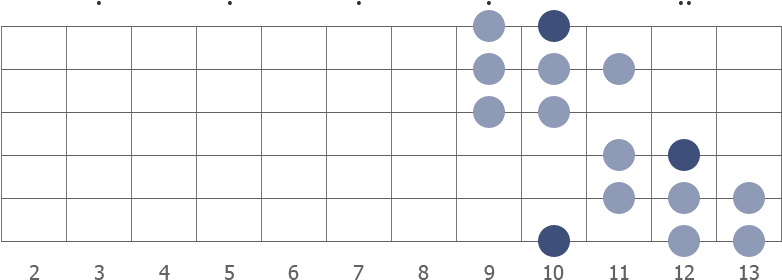D Gypsy Minor
D Gypsy Minor scale for guitar.
The D Gypsy Minor is a seven-note scale. Notes are displayed in the diagram with blue color with the root notes indicated by darker color. In the two-octave pattern, the first root note appears on the 6th string, 10th fret.
Dm
2 octaves
 Notes: D - E - F - G# - A - Bb - C#
Intervals: 2 - 1 - 3 - 1 - 1 - 3 - 1
Type: Septonic
Notes: D - E - F - G# - A - Bb - C#
Intervals: 2 - 1 - 3 - 1 - 1 - 3 - 1
Type: Septonic
The scale displayed with its numeric formula, notes, intervals and scale degrees.
| Formula | Notes | Intervals | Degrees |
|---|---|---|---|
| 1 | D | Unison | Tonic |
| 2 | E | Major second | Supertonic |
| b3 | F | Minor third | Mediant |
| #4 | G# | Augmented fourth | Subdominant |
| 5 | A | Perfect fifth | Dominant |
| b6 | Bb | Minor sixth | Submediant |
| 7 | C# | Major seventh | Leading tone |
The main three-note and four-note chords that can be harmonized from this scale are the following:
| Name | Notation | Name | Notation |
|---|---|---|---|
| Dm | XX0231 | Dm7 | XX0211 |
| E-5 | XX2354 | E7-5 | X12334 |
| Faug | X8766X | FM7#5 | 10222X |
| G#sus2 | XX6355 | N/A | N/A |
| A | X02220 | Amaj7 | X02120 |
| Bb | 466544 | Bbmaj7 | 465544 |
| C#m | X46654 | C#m6 | XX2324 |
The tones in these chords correspond to the tones of the D Gypsy Minor scale.
The second and fourth columns include short notations for the chords in the first and third columns respectively. These are based on common ways to play the chord, but there are other alternatives. See more about this notation system on the FAQ page.
The D Gypsy Minor consists of seven notes. These can be described as intervals, based on semi-notes or steps on the guitar fingerboard, written as 2 - 1 - 3 - 1 - 1 - 3 - 1 from the first note to the next octave.
The scale can be played on the guitar from different starting positions in which D functions as the tonic.
The D Gypsy Minor is also referred to as the D Hungarian Minor scale. It should not be confused with the
D Gypsy Major scale.
Start the audio and play along with your guitar! Use notes from the scale in the diagram above.
Normal tempo: